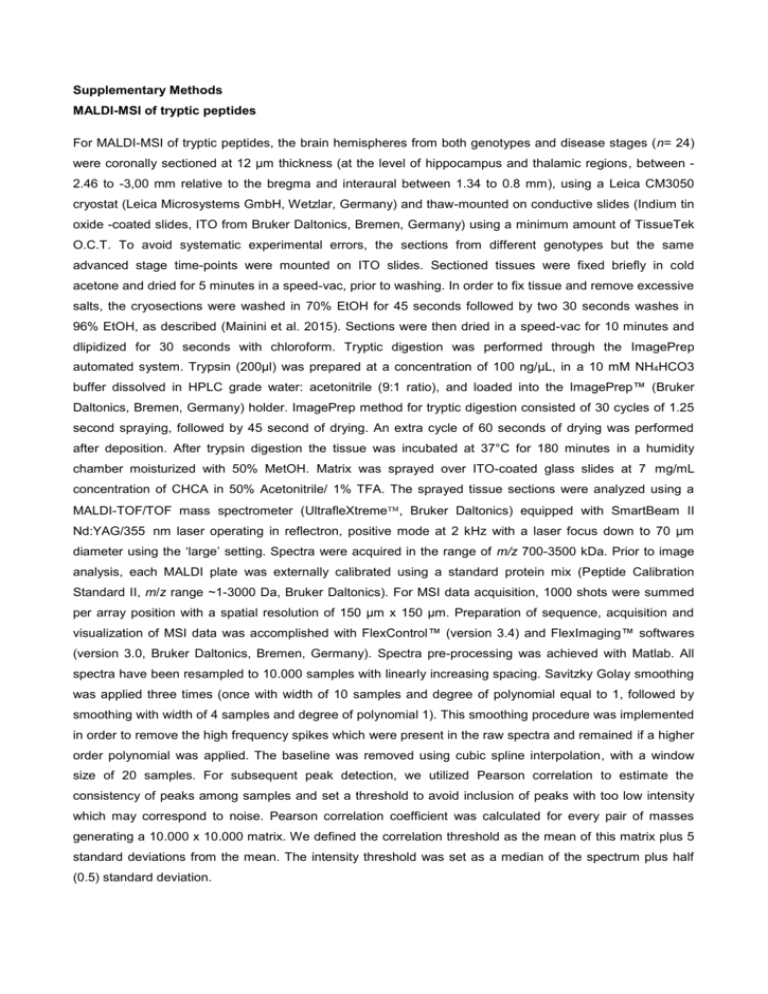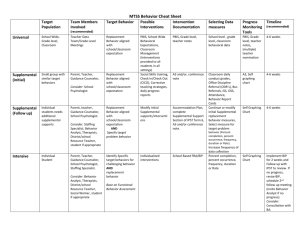Supplementary Methods MALDI-MSI of tryptic peptides For MALDI
advertisement

Supplementary Methods MALDI-MSI of tryptic peptides For MALDI-MSI of tryptic peptides, the brain hemispheres from both genotypes and disease stages (n= 24) were coronally sectioned at 12 µm thickness (at the level of hippocampus and thalamic regions, between 2.46 to -3,00 mm relative to the bregma and interaural between 1.34 to 0.8 mm), using a Leica CM3050 cryostat (Leica Microsystems GmbH, Wetzlar, Germany) and thaw-mounted on conductive slides (Indium tin oxide -coated slides, ITO from Bruker Daltonics, Bremen, Germany) using a minimum amount of TissueTek O.C.T. To avoid systematic experimental errors, the sections from different genotypes but the same advanced stage time-points were mounted on ITO slides. Sectioned tissues were fixed briefly in cold acetone and dried for 5 minutes in a speed-vac, prior to washing. In order to fix tissue and remove excessive salts, the cryosections were washed in 70% EtOH for 45 seconds followed by two 30 seconds washes in 96% EtOH, as described (Mainini et al. 2015). Sections were then dried in a speed-vac for 10 minutes and dlipidized for 30 seconds with chloroform. Tryptic digestion was performed through the ImagePrep automated system. Trypsin (200μl) was prepared at a concentration of 100 ng/μL, in a 10 mM NH4HCO3 buffer dissolved in HPLC grade water: acetonitrile (9:1 ratio), and loaded into the ImagePrep™ (Bruker Daltonics, Bremen, Germany) holder. ImagePrep method for tryptic digestion consisted of 30 cycles of 1.25 second spraying, followed by 45 second of drying. An extra cycle of 60 seconds of drying was performed after deposition. After trypsin digestion the tissue was incubated at 37°C for 180 minutes in a humidity chamber moisturized with 50% MetOH. Matrix was sprayed over ITO-coated glass slides at 7 mg/mL concentration of CHCA in 50% Acetonitrile/ 1% TFA. The sprayed tissue sections were analyzed using a MALDI-TOF/TOF mass spectrometer (UltrafleXtreme, Bruker Daltonics) equipped with SmartBeam II Nd:YAG/355 nm laser operating in reflectron, positive mode at 2 kHz with a laser focus down to 70 µm diameter using the ‘large’ setting. Spectra were acquired in the range of m/z 700-3500 kDa. Prior to image analysis, each MALDI plate was externally calibrated using a standard protein mix (Peptide Calibration Standard II, m/z range ~1-3000 Da, Bruker Daltonics). For MSI data acquisition, 1000 shots were summed per array position with a spatial resolution of 150 µm x 150 µm. Preparation of sequence, acquisition and visualization of MSI data was accomplished with FlexControl™ (version 3.4) and FlexImaging™ softwares (version 3.0, Bruker Daltonics, Bremen, Germany). Spectra pre-processing was achieved with Matlab. All spectra have been resampled to 10.000 samples with linearly increasing spacing. Savitzky Golay smoothing was applied three times (once with width of 10 samples and degree of polynomial equal to 1, followed by smoothing with width of 4 samples and degree of polynomial 1). This smoothing procedure was implemented in order to remove the high frequency spikes which were present in the raw spectra and remained if a higher order polynomial was applied. The baseline was removed using cubic spline interpolation, with a window size of 20 samples. For subsequent peak detection, we utilized Pearson correlation to estimate the consistency of peaks among samples and set a threshold to avoid inclusion of peaks with too low intensity which may correspond to noise. Pearson correlation coefficient was calculated for every pair of masses generating a 10.000 x 10.000 matrix. We defined the correlation threshold as the mean of this matrix plus 5 standard deviations from the mean. The intensity threshold was set as a median of the spectrum plus half (0.5) standard deviation. Supplemental Figures legends Supplemental Figure S1. Analysis of the differentially expressed proteins in the Ppt1-/- thalamus at the symptomatic stage. Proteins that were differentially expressed in the Ppt1-/- thalamus were linked using Ingenuity pathways (IPA) algorithms. Network 1 linked 35 molecules including 17 differentially expressed proteins while the second network linked 35 proteins including 10 differentially expressed ones. The networks with the highest IPA scores are portrayed. Protein families’ annotation: rhomb- enzyme, trianglekinase, horizontal oval- transcriptional activator, vertical oval- transmembrane receptor, pentagontransporter, circle- other. Green coloring- proteins with down-regulated expression, in red- proteins with upregulated expression. The different shades in coloring portray changes in protein expression from less to more down-(up)-regulated. For details see Online Resource 7, Supplemental Table S7. Supplemental Figure S2. Interaction network linking differentially expressed proteins at the symptomatic stage. Differentially expressed proteins in the thalamus of the Ppt1-/- mice were connected using multiple interaction data and filtered for Gene Ontology biological process participation. Using these criteria 88 proteins were connected. A) The regulation of vesicle-mediated transport (P= 6.58E-9) linked 14 nodes of the network including 5 differentially expressed ones and PPT1. Inset presents a 3-node functional module formed by PPT1 interacting partner Atp5b/ATP5B (Lyly et al. 2008; Scifo et al. 2015a; Scifo et al. 2015b), Atpa1/ATPA1 and Atpaf1/ATPAF1. The down-regulation of Stx1a/STX1A and Vamp2/VAMP2 axis (Kim et al. 2008) is confirmed in this study and depicted in the upper inset. B) Synaptic vesicle transport (P = 6.03E-7) encompassing 8 molecules is depicted. The functional attributes of the network nodes including being parts of PPT1, CLN3/CLN5 interactomes or lipofuscin and myelin proteomes, and those validated by other methods are portrayed (for details see Online Resource 2 and 5, Supplemental Tables S2 and S5). Supplemental Figure S3. Immunohistochemical analysis of glial acidic fibrillary protein immunoreactivity in the thalamus. The immunoreactivity with Gfap/GFAP- specific antibodies was studied at symptomatic and advanced stages, respectively. A strong up-regulation of immunoreactivity specifically in GFAP-positive astrocytes of Ppt1-/- thalamus can be observed. Scale bars- 200 µm and 50 µm respectively. Supplemental Figure S4. Representation of Signaling by Rho Family GTPases pathway affected in CLN1 deficiency. A) The dysregulation of this signaling pathway at the symptomatic and advanced stages in the Ppt1-/- thalamus is depicted. Differentially up-regulated proteins are shown in magenta while downregulated are illustrated in light green. The dysregulated genes associated with this pathway, which were previously determined by microarray profiling (Jalanko et al. 2005; von Schantz et al. 2008) are also listed. B) Transcriptomic analysis in fibroblasts derived from two CLN1 disease patients, with missense mutation p.(Leu222Pro; patient 1) (Simonati et al. 2009) and single adenine insertion p.(Met57Asnfs*45; patient 2) (Santorelli et al. 1998) validated the down-regulation of the same pathway (respective Z scores= -1.941 with 15 molecules assigned and Z= -2.324 with 16 molecules assigned). Supplemental Figure S5. Down-regulation of myelin sheath components at the advanced stage. Three proteins linked to ensheathment of axons, namely claudin 11 (Cldn11/CLDN11), proteolipid 1 (Plp1/PLP1) and myelin basic protein (MbP/MBP) are strongly down-regulated in their expression in the Ppt1-/- thalamus at the advanced stage (upper panel). The down-regulated protein CLDN11 forms tight junction complex (P= E-28), together with other claudins (CLDNs), tetraspanins (TSPANs) and integrin beta 1 (ITGB1), as predicted by various interaction data (depicted in the lower panel). Supplemental Figure S6. Depiction of overall average MALDI-MSI spectra measured in wild-type and Ppt1-/- brain. The MALDI-MSI was performed at the pre-symptomatic, symptomatic and advanced stages, respectively. Over 900 peaks were detected based on the peak detection algorithm implemented in Matlab. The spectra were recorded in positive, average mode on UltrafleXtreme spectrometer. Lateral resolution 150µm x 150µm. The details of MSI measurements (see Online Resource 15, Supplemental Material and Methods). Supplemental Figure S7. Myelin basic proteins detected in wild-type and Ppt1-/- brain. A) Two different isoforms of Mbp detected in LC-MSE experiments at the advanced stage. The brain tissue slices were digested with trypsin, and the digests from selected brain regions, pinpointed by immunohistochemistry (Figure 8E) were resolved by LC-MSE. The sequences of Mbp peptides detected in these experiments are underlined. Phosphorylated Tyrosine (T) measured in the LC-MSE experiments (Supplemental Table S13) is shown in orange. Boxed sequences-peptides detected in MALDI-MSI experiments. In magenta- MbP peptide (HGFLPR, m/z 726.67) measured in MALDI-MSI experiments of tryptic peptides on tissues, shown in B). The Mbp peptides were measured in MALDI-MSI experiments in reflectron, positive mode on UltrafleXtreme spectrometer. For details of the procedure see Supplemental Material and Methods. The mean of peak intensity is indicated. Relative intensity: dark blue- 0% intensity, red 100% intensity. The maximum peak intensity in each image was set at 100%. T- Total ion current normalization (TIC). Supplemental Figure S8. Differentially expressed m/z at the advanced stage. The m/z with differential expression in the Ppt1-/- brain at the advanced stage measured in MALDI-MSI experiments. 24 m/z with differential expression were detected at this stage, pointed by the arrows. The spectra were recorded in positive, average mode on UltrafleXtreme spectrometer. The means of each differential m/z are shown. The details of differential m/z peak statistics are provided in Online Resource 12, Supplemental Table S12. Supplemental references Jalanko, A., Vesa, J., Manninen, T., von Schantz, C., Minye, H., Fabritius, A. L., et al. (2005). Mice with Ppt1Deltaex4 mutation replicate the INCL phenotype and show an inflammation-associated loss of interneurons. Neurobiology of Disease, 18(1), 226-241. Kim, S. J., Zhang, Z., Sarkar, C., Tsai, P. C., Lee, Y. C., Dye, L., et al. (2008). Palmitoyl protein thioesterase1 deficiency impairs synaptic vesicle recycling at nerve terminals, contributing to neuropathology in humans and mice. The Journal of Clinical Investigation, 118(9), 3075-3086, doi:10.1172/JCI33482. Lyly, A., Marjavaara, S. K., Kyttala, A., Uusi-Rauva, K., Luiro, K., Kopra, O., et al. (2008). Deficiency of the INCL protein Ppt1 results in changes in ectopic F1-ATP synthase and altered cholesterol metabolism. Human Molecular Genetics, 17(10), 1406-1417. Scifo, E., Szwajda, A., Soliymani, R., Pezzini, F., Bianchi, M., Dapkunas, A., et al. (2015a). Quantitative analysis of PPT1 interactome in human neuroblastoma cells. Data in Brief, 4, 207-216. Scifo, E., Szwajda, A., Soliymani, R., Pezzini, F., Bianchi, M., Dapkunas, A., et al. (2015b). Proteomic analysis of the palmitoyl protein thioesterase 1 interactome in SH-SY5Y human neuroblastoma cells. Journal of Proteomics, 123, 42-53. Simonati, A., Tessa, A., Bernardina, B. D., Biancheri, R., Veneselli, E., Tozzi, G., et al. (2009). Variant late infantile neuronal ceroid lipofuscinosis because of CLN1 mutations. Pediatric Neurology, 40(4), 271276. von Schantz, C., Saharinen, J., Kopra, O., Cooper, J. D., Gentile, M., Hovatta, I., et al. (2008). Brain gene expression profiles of Cln1 and Cln5 deficient mice unravels common molecular pathways underlying neuronal degeneration in NCL diseases. BMC Genomics, 9, 146.






